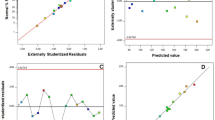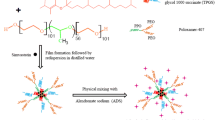Abstract
Fluvastatin (FLV) is known to inhibit the 3-hydroxy-3-methylglutaryl coenzyme A (HMG-CoA), which is over-expressed in various cancers. FLV has been reported to decrease cancer development and metastasis. However, because of low bioavailability, extensive first-pass metabolism and short half-life of FLV (1.2 h), it is not appropriate for clinical application. Therefore, FLV-loaded emulsomes were formulated and optimized using Box–Behnken experimental design to achieve higher efficiency of formulation. Antitumor activity of optimized FLV-loaded emulsomes was evaluated in prostate cancer cells using cell cytotoxicity, apoptotic activity, cell cycle analysis, and enzyme-linked immunosorbent assay. The FLV-loaded emulsomes exhibited a monodispersed size distribution with a mean particle size less than 100 nm as measured by zetasizer. The entrapment efficiency was found to be 93.74% with controlled drug release profile. FLV-EMLs showed a significant inhibitory effect on the viability of PC3 cells when compared to the free FLV (P < 0.0025). Furthermore, FLV-EMLs showed significant arrest in G2/M and increase in percentage of apoptotic cells as compared to free FLV. FLV-EMLs were more effective than free FLV in reducing mitochondrial membrane potential and increase in caspase-3 activity. These results suggesting that FLV-EMLs caused cell cycle arrest which clarifies its significant antiproliferative effect compared to the free drug. Therefore, optimized FLV-EMLs may be an effective carrier for FLV in prostate cancer treatment.









Similar content being viewed by others
Change history
02 June 2023
This article has been retracted. Please see the Retraction Notice for more detail: https://doi.org/10.1208/s12249-023-02591-y
References
Hsing AW, Chokkalingam AP. Epidemiology of prostate cancer. Prostate Cancer Basic Mech Ther Approaches. Elmer Press. 2005:315–63.
Hayat MJ, Howlader N, Reichman ME, Edwards BK. Cancer statistics, trends, and multiple primary cancer analyses from the Surveillance, Epidemiology, and End Results (SEER) program. Oncologist Alphamed Press. 2007;12:20–37.
Bosland MC. Is there a future for chemoprevention of prostate cancer? Cancer Prev. Res. American Association for Cancer Research Inc.; 2016. p. 642–7.
Fahmy UA. Augmentation of fluvastatin cytotoxicity against prostate carcinoma PC3 cell line utilizing alpha lipoic–ellagic acid nanostructured lipid carrier formula. AAPS PharmSciTech. 2018;19:3454–61.
Mahmoudi R, Ashraf Mirahmadi-Babaheidri S, Delaviz H, Fouani MH, Alipour M, Jafari Barmak M, et al. RGD peptide-mediated liposomal curcumin targeted delivery to breast cancer cells. J Biomater Appl SAGE Publications Ltd. 2021;35:743–53.
Mahmoudi R, Hassandokht F, Ardakani MT, Karimi B, Roustazadeh A, Tarvirdipour S, et al. Intercalation of curcumin into liposomal chemotherapeutic agent augments apoptosis in breast cancer cells. J Biomater Appl SAGE Publications Ltd. 2020;35.
Torchilin VP, Levchenko TS. TAT-liposomes: a novel intracellular drug carrier. Curr Protein Pept Sci. 2003;4:133–40.
Quagliariello V, Masarone M, Armenia E, Giudice A, Barbarisi M, Caraglia M, et al. Chitosan-coated liposomes loaded with butyric acid demonstrate anticancer and anti-inflammatory activity in human hepatoma HepG2 cells. Oncol Rep. 2018;41:1476–86.
Khan MI, Madni A, Ahmad S, Mahmood MA, Rehman M, Ashfaq M. Formulation design and characterization of a non-ionic surfactant based vesicular system for the sustained delivery of a new chondroprotective agent. Brazilian J Pharm Sci Faculdade de Ciencias Farmaceuticas (Biblioteca). 2015;51:607–16.
Kaur IP, Rana C, Singh M, Bhushan S, Singh H, Kakkar S. Development and evaluation of novel surfactant-based elastic vesicular system for ocular delivery of fluconazole. J Ocul Pharmacol Ther. 2012;28:484–96.
Nasr M, Mansour S, Mortada ND, Elshamy AA. Vesicular aceclofenac systems: a comparative study between liposomes and niosomes. J Microencapsul Informa UK Ltd UK. 2008;25:499–512.
Jain S, Umamaheshwari RB, Bhadra D, Jain NK. Ethosomes: a novel vesicular carrier for enhanced transdermal delivery of an antiHIV agent. Indian J Pharm Sci Medknow Publications. 2004;66:72–81.
Rajan R, Jose S, Mukund V. Transferosomes—a vesicular transdermal delivery system for enhanced drug permeation. J Adv Pharm Technol Res. 2011;2:138–43.
Lakshmi PK, Kalpana B, Prasanthi D. Invasomes-novel vesicular carriers for enhanced skin permeation. Syst Rev Pharm. 2013:26–30.
Song CK, Balakrishnan P, Shim CK, Chung SJ, Chong S, Kim DD. A novel vesicular carrier, transethosome, for enhanced skin delivery of voriconazole: characterization and in vitro/in vivo evaluation. Colloids Surf B: Biointerfaces. Elsevier B.V. 2012;92:299–304.
Azeez NA, Deepa VS, Sivapriya V. Phytosomes: emergent promising nano vesicular drug delivery system for targeted tumor therapy. Adv. Nat. Sci. Nanosci. Nanotechnol. IOP Publishing; 2018. 33001.
Bardania H, Shojaosadati SA, Kobarfard F, Morshedi D, Aliakbari F, Tahoori MT, et al. RGD-modified nano-liposomes encapsulated eptifibatide with proper hemocompatibility and cytotoxicity effect. Iran J Biotechnol. National Institute of Genetic Engineering and Biotechnology. 2019;17:8–13.
El-Nabarawi M, Bendas E, El Rehem R, MY A. Transdermal drug delivery of paroxetine through lipid-vesicular formulation to augment its bioavailability. Int J Pharm. 2013;443:307–17.
Amselem S, Yogev A, Zawoznik E, Friedman D. Emulsomes, a novel drug delivery technology. Proc Control Release Soc. 1994. p. 668–9.
Ucisik M, Sleytr U, Schuster B. Emulsomes meet S-layer proteins: an emerging targeted drug delivery system. Curr Pharm Biotechnol. Bentham Science Publishers. 2015;16:392–405.
Vyas SP, Subhedar R, Jain S. Development and characterization of emulsomes for sustained and targeted delivery of an antiviral agent to liver. J Pharm Pharmacol. 2006;58:321–6.
Alhakamy NA, Badr-Eldin SM, Ahmed OAA, Asfour HZ, Aldawsari HM, Algandaby MM, et al. Piceatannol-loaded emulsomes exhibit enhanced cytostatic and apoptotic activities in colon cancer cells. Antioxidants. MDPI AG. 2020;9:419.
Awan ZA, Fahmy UA, Badr-eldin SM, Ibrahim TS, Asfour HZ, Al-rabia MW, et al. The enhanced cytotoxic and pro-apoptotic effects of optimized simvastatin-loaded emulsomes on MCF-7 breast cancer cells. Pharmaceutics. 2020;12:1–22.
Bolat ZB, Islek Z, Demir BN, Yilmaz EN, Sahin F, Ucisik MH. Curcumin- and piperine-loaded emulsomes as combinational treatment approach enhance the anticancer activity of curcumin on HCT116 colorectal cancer model. Front Bioeng Biotechnol. Frontiers Media S.A. 2020;8:50.
Raza K, Katare OP, Setia A, Bhatia A, Singh B. Improved therapeutic performance of dithranol against psoriasis employing systematically optimized nanoemulsomes. J Microencapsul. 2013;30:225–36.
Pal A, Gupta S, Jaiswal A, Dube A, Vyas SP. Development and evaluation of tripalmitin emulsomes for the treatment of experimental visceral leishmaniasis. J Liposome Res. 2012;22:62–71.
Ucisik MH, Küpcü S, Schuster B, Sleytr UB. Characterization of CurcuEmulsomes: Nanoformulation for enhanced solubility and delivery of curcumin. J Nanobiotechnology. 2013;11:37.
Varshosaz J, Raghami F, Rostami M, Jahanian A. PEGylated trimethylchitosan emulsomes conjugated to octreotide for targeted delivery of sorafenib to hepatocellular carcinoma cells of HepG2. J Liposome Res Taylor & Francis. 2019;29:383–98.
Ucisik MH, Küpcü S, Breitwieser A, Gelbmann N, Schuster B, Sleytr UB. S-layer fusion protein as a tool functionalizing emulsomes and CurcuEmulsomes for antibody binding and targeting. Colloids Surf B: Biointerfaces. 2015;128:132–9.
Paliwal R, Paliwal SR, Mishra N, Mehta A, Vyas SP. Engineered chylomicron mimicking carrier emulsome for lymph targeted oral delivery of methotrexate. Int J Pharm. 2009;380:181–8.
Zhong GC, Liu Y, Ye YY, Hao FB, Wang K, Gong JP. Meta-analysis of studies using statins as a reducer for primary liver cancer risk. Sci Rep. 2016;6:26256.
Zhang W, Wu J, Zhou L, Xie H-Y, Zheng S-S. Fluvastatin, a lipophilic statin, induces apoptosis in human hepatocellular carcinoma cells through mitochondria-operated pathway. Indian J Exp Biol. 2010;48:1167–74.
Ishikawa S, Hayashi H, Kinoshita K, Abe M, Kuroki H, Tokunaga R, et al. Statins inhibit tumor progression via an enhancer of zeste homolog 2-mediated epigenetic alteration in colorectal cancer. Int J Cancer. 2014;135:2528–36.
Higashi T, Hayashi H, Kitano Y, Yamamura K, Kaida T, Arima K, et al. Statin attenuates cell proliferative ability via TAZ (WWTR1) in hepatocellular carcinoma. Med Oncol. 2016;33:123.
Graaf MR, Richel DJ, van Noorden CJF, Guchelaar HJ. Effects of statins and farnesyltransferase inhibitors on the development and progression of cancer. Cancer Treat Rev. 2004:609–41.
Van Wyhe RD, Rahal OM, Woodward WA. Effect of statins on breast cancer recurrence and mortality: a review. Breast Cancer Targets Ther. 2017. 559–65.
Stancu C, Sima A. Statins: Mechanism of action and effects. J Cell Mol Med. 2001;5:378–87.
El-Helw A-RMA-RM, Fahmy UA. Improvement of fluvastatin bioavailability by loading on nanostructured lipid carriers. Int J Nanomedicine. Dove Press. 2015;10:5797–804.
Fahmy UA, Aldawsari HMHM, Badr-Eldin SMSM, Ahmed OAAOAA, Alhakamy NANA, Alsulimani HHH, et al. The encapsulation of febuxostat into emulsomes strongly enhances the cytotoxic potential of the drug on HCT 116 colon cancer cells. Pharmaceutics. 2020;12:1–17.
Ahmed OAA, Badr-Eldin SM. Development of an optimized avanafil-loaded invasomal transdermal film: ex vivo skin permeation and in vivo evaluation. Int J Pharm. Elsevier B.V.; 2019;570.
Fahmy UA, Badr-Eldin SM, Ahmed OAA, Aldawsari HM, Tima S, Asfour HZ, et al. Intranasal niosomal in situ gel as a promising approach for enhancing flibanserin bioavailability and brain delivery: in vitro optimization and ex vivo/in vivo evaluation. Pharmaceutics. Multidisciplinary Digital Publishing Institute. 2020;12:485.
Badr-Eldin SM, Alhakamy NA, Fahmy UA, Ahmed OAA, Asfour HZ, Althagafi AA, et al. Cytotoxic and pro-apoptotic effects of a sub-toxic concentration of fluvastatin on OVCAR3 ovarian cancer cells after its optimized formulation to melittin nano-conjugates. Front Pharmacol. Frontiers. 2021;11:642171.
Beckwitt CH, Brufsky A, Oltvai ZN, Wells A. Statin drugs to reduce breast cancer recurrence and mortality. Breast Cancer Res. BioMed Central; 2018. 144.
Manthravadi S, Shrestha A, Madhusudhana S. Impact of statin use on cancer recurrence and mortality in breast cancer: a systematic review and meta-analysis. Int. J. Cancer. Wiley-Liss Inc.; 2016. p. 1281–8.
Hindler K, Cleeland CS, Rivera E, Collard CD. The role of statins in cancer therapy. Oncologist AlphaMed. Press. 2006;11:306–15.
Blanco E, Shen H, Ferrari M. Principles of nanoparticle design for overcoming biological barriers to drug delivery. Nat. Biotechnol. Nature Publishing Group; 2015. p. 941–51.
Murugan K, Choonara YE, Kumar P, Bijukumar D, du Toit LC, Pillay V. Parameters and characteristics governing cellular internalization and trans-barrier trafficking of nanostructures. Int J Nanomedicine. Dove Medical Press Ltd. 2015;10:2191–206.
Pelaia G, Gallelli L, Renda T, Fratto D, Falcone D, Caraglia M, et al. Effects of statins and farnesyl transferase inhibitors on ERK phosphorylation, apoptosis and cell viability in non-small lung cancer cells. Cell Prolif. 2012;45:557–65.
Li Y, Fu J, Yuan X, Hu C. Simvastatin inhibits the proliferation of A549 lung cancer cells through oxidative stress and up-regulation of SOD2. Pharmazie. 2014;69:610–4.
Md S, Alhakamy NA, Aldawsari HM, Husain M, Kotta S, Abdullah ST, et al. Formulation design, statistical optimization, and in vitro evaluation of a naringenin nanoemulsion to enhance apoptotic activity in A549 lung cancer cells. Pharmaceuticals (Basel, Switzerland). 2020;13(7):152.
Sheikholeslami K, Sher AA, Lockman S, Kroft D, Ganjibakhsh M, Nejati-Koshki K, et al. Simvastatin induces apoptosis in medulloblastoma brain tumor cells via mevalonate cascade prenylation substrates. Cancers (Basel). MDPI AG; 2019;11.
Qi XF, Zheng L, Lee KJ, Kim DH, Kim CS, Cai DQ, et al. HMG-CoA reductase inhibitors induce apoptosis of lymphoma cells by promoting ROS generation and regulating Akt, Erk and p38 signals via suppression of mevalonate pathway. Cell Death Dis. 2013;4:e518.
Khodayar S, Bardania H, Shojaosadati SA. Bagheri F. Optimization and characterization of aspirin encapsulated nano-liposomes. Iran J Pharm Res. 2018;17:11–22.
Acknowledgements
The authors acknowledge with thanks DSR for technical support.
Funding
This project was funded by the Deanship of Scientific Research (DSR) at King Abdulaziz University, Jeddah, under grant no. (RG-3-166-41).
Author information
Authors and Affiliations
Corresponding author
Ethics declarations
Conflict of Interest
The authors declare no competing interests.
Additional information
Publisher’s Note
Springer Nature remains neutral with regard to jurisdictional claims in published maps and institutional affiliations.
This article has been retracted. Please see the retraction notice for more detail: https://doi.org/10.1208/s12249-023-02591-y
Rights and permissions
Springer Nature or its licensor (e.g. a society or other partner) holds exclusive rights to this article under a publishing agreement with the author(s) or other rightsholder(s); author self-archiving of the accepted manuscript version of this article is solely governed by the terms of such publishing agreement and applicable law.
About this article
Cite this article
Alhakamy, N.A., Badr-Eldin, S.M., Aldawsari, H.M. et al. RETRACTED ARTICLE: Fluvastatin-Loaded Emulsomes Exhibit Improved Cytotoxic and Apoptosis in Prostate Cancer Cells. AAPS PharmSciTech 22, 177 (2021). https://doi.org/10.1208/s12249-021-02021-x
Received:
Accepted:
Published:
DOI: https://doi.org/10.1208/s12249-021-02021-x




